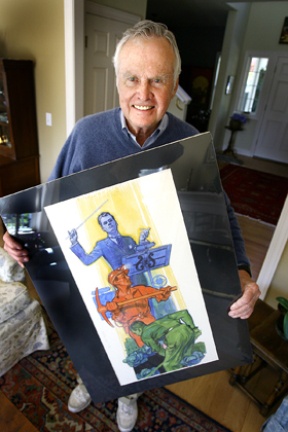Unknown original works by Herbert Paus show the illustrator’s iconic American talent.
When Herbert Paus, a contemporary of Norman Rockwell famous for his World War I and World War II posters, magazine covers and children’s book illustrations died in 1946, a boxed collection of his work went to his daughter, Patricia.
When she passed away, her brother Jack Paus assumed ownership. He didn’t consider the acquisition earth-shattering.
“We transferred the boxes from her attic to my attic,” he said.
This isn’t to say that Jack doesn’t understand the significance of his father’s work. But more than being an artist, Herbert was Jack’s father – the man who took him to baseball games and to witness Joe Louis knock out Max Baer in four rounds.
Now, Jack finds himself a bemused participant in a somewhat urgent restoration and curatorial effort spearheaded by Bainbridge artists Francis Gace and Darrell Anderson that will culminate in a show at Wing Point Golf and Country Club at the end of the month.
“We’re preserving a natural treasure. It’s really remarkable,” Gace said.
When Gace met Jack at the Wing Point Golf and Country Club earlier this year, the two got to talking about art and artists – Gace, a portrait painter, also arranges the club’s rotating gallery exhibitions.
Jack mentioned the cache that was unassumingly packaged up in his house, and Gace jumped at the opportunity to look at the work.
What he found was a large survey of original paintings, drawings and illustrations by an artist whose work he says captured “the history and mood of our country through two world wars, the scientific and industrial exuberance of the Roaring Twenties, and the hard grind of the Great Depression.”
As soon as Gace laid eyes on the collection he knew they needed to be preserved. He called on Anderson, and the two set about uncovering and cataloguing the pieces.
Herbert, largely unschooled but displaying a keen illustrative facility even at a young age, gained fame with his powerful World War I and World War II posters, rendered in glowing, heavily outlined primaries that set forth the United States as a determined beacon of power and peace.
But the artist swung easily from stern, nationalistic pieces to what Gace calls “these lovely, magical illustrations” for children’s books such as Madam Maeterlinck’s “The Children’s Bluebird” and the work of Martha Cheavens.
Art historians often discuss Paus and Rockwell in the same breath, and while Rockwell’s name may be better known, Gace and Anderson point out that Paus was actually Rockwell’s mentor and that Paus influenced key elements of Rockwell’s straightforward style.
The two artists socialized; Rockwell lived in New Rochelle, N.Y., one town over from the Paus’ Mamaroneck place.
Jack recalls standing on the second-floor interior balcony of the house Herbert designed and built in 1922, watching Rockwell and his father talking over dinner. The two also participated in monthly evening sketch sessions at the house.
Herbert’s posters and illustrations point to an artist who produced his commissions steadily and in a workmanlike fashion, with no tortured angst hampering his progress.
Gace says that during their lifetimes, illustrators like Paus and Rockwell were often eschewed as “commercial artists” unworthy of gallery or museum status; only in the late 20th century were they formally recognized as fine artists.
The artist’s technical expertise and versatility are clear in the range of work in his son’s collection. But an added exuberance emerges in a set of three oil paintings in Jack’s dining room and entry.
In art-deco, Klimt-like splendor, they depict mythical scenes of a broomstick-riding witch accompanied by feline familiars; a pierrot in triplicate on a folding screen; and a triad of bathing beauties – “my mother three times,” Jack said.
The jewel-like colors and gold leaf ornamentation pulse with magic and whimsy; the paintings clearly offered Herbert an opportunity to let go.
Also clear in all of Herbert’s work is an expansive, tender affection for his family. The faces of Betty, Jack and Patricia appear in illustration after illustration, from war posters to magazine covers to private illustrations like the assortment of fireside family studies he compiled into an album titled “Betty Paus – Xmas 1932.”
In addition to working with Gace and Anderson to curate the Wing Point show, Jack has agreed to put one of his father’s pieces up for auction on ebay to benefit Helpline House, a regular Wing Point donation recipient. “Cabbage Patch Patriots” depicts in vivid primary colors a miner, a band member and a farmer all doing their part for the World War I effort.
Gace describes the ways in which the painting is “iconic of Herbert Paus.” Jack interjects at one point, saying, “You know all this stuff I’ve never heard of.”
Right now, Gace and Anderson are acting as what Gace terms a two-person “preservation factory,” mounting the pieces on acid-free mats and shrink-wrapping them in archival plastic. They’d love to see the work framed, but monetary constraints and the sheer volume of work necessitated a faster and more budget-conscious solution.
“This is Darrell’s brilliant solution to the situation we’re faced with, with work deteriorating in cardboard boxes,” Gace said.
Jack thinks his father’s work is “terrific” but shakes his head a little when he talks about the preparation for the upcoming show.
“It’s something else,” he said. But at heart, he says he “much appreciates” the efforts that Gace and Anderson are taking to preserve his father’s work.
“We are so lucky to have this,” Anderson said. “By rights, this should be displayed in New York at the American Society of Illustrators. And we just bumped into Jack.”
************
Rare vision
The work of Herbert Paus, from the private collection of Jack Paus, will be on display at Wing Point Golf and Country Club from May 27 through July 6 with an opening reception on May 26 by invitation. For more information about the exhibition, call 842-2688.



